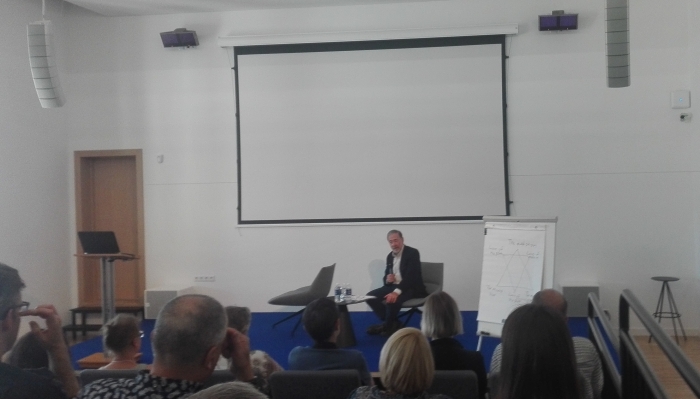
Professor David Roskies delivered an interesting lecture to a medium-sized audience at the new Judaica Center at the Lithuanian National Library Thursday evening.
“Using the tools of a cultural historian, drawing upon my Litvak identity and turning feminism into a source of knowledge, I think I have successfully cracked the DNA of Jewish collective memory. I know what it is, and I know how it works. Jewish collective memory is organized around saints, sanctuaries and sacred times. In this way, each generation of Jews shape a model life, the model community and the model time. You don’t have to be a Litvak to unlock the DNA of Jewish collective memory, but it certainly helps, because Lite [Lithuania] is where this triple axis, this three-pronged model, emerged in bold relief. The model was so stable that it remained in place even when the world began to change. In Lite things really began to change with the rise of religious revival movement called Hassidism at the end of the 18th century. So long as the hassidim were limited to Podolia and Volhynia which, after all, are located south of the gefilte fish line, and where people spoke a different Yiddish, there wasn’t much to worry about. So there was talk about a new cultural hero named Yisroel Ba’al Shem-Tov, better known as Besht. He was a faith healer, a tzadik or saintly person, a righteous person, who engaged in all manner of non-Litvak behavior. He was an effective preacher and teacher, but he came into conflict with renowned Torah scholars, who were the elite of traditional society. Worse yet, he popularized the study of Kabbalah–Jewish mysticism–, he claimed to have paid periodic visits to Heaven and he encouraged mystical prayer performed with bizarre and ecstatic song and dance at all hours. Then, before you knew it, hassidic prayer houses were beginning to appear in Lite, too. The time had come for the rabbinic establishment to take action,” Rosskies said in a lecture which ranged seamlessly from the drier facts of cultural history to his own personal experiences and thoughts, employing moving Yiddish lullabies to make certain points.
“There was only person who could stand up to this new model of spiritual leadership,” he continued, “and that was Elijah ben Solomon Zalman, in whose honor the title of ga’on was resurrected after a break of 400 years. As the Besht became the founding father of Hassidism, the Vilna Gaon became the founder of the opponents, the misnagdim. But while the origins of Hassidism are still shrouded … we know with absolute precision when and how the misnagdic counter-movement came into being. It happened in 1772 when, for only the second time in his life, Elijah entered the Shtot-Shul in Vilna. There he read aloud the excommunication decree against the hassidim. The first time he was in the Shtot-Shul was when he delivered a talmudic discourse there at the age of was six-and-a-half. He was really a child talmudic prodigy, an iluy. In Jewish collective memory, the text of the herem, the Jewish excommunication decree, does not loom nearly as large as Martin Luther’s Ninety-five Theses. Most people, including me, have never read it. The Gaon of Vilna’s memory is revered in other ways. His influence spread far and wide through two portable memory sites, one elite and the other popular. In elite circles, no edition of the Shas, the Babylonian Talmud, was complete without Hagahot ha-GRA, his textual glosses and emendations that appear on the margins of the folio-size page of the Talmud, especially the Vilna Shas published by the widow Romm and her sons became the gold standard of the Babylonian Talmud. This made the Gaon of Vilna a timeless textual presence. Every time you opened a Bloch Gemarah, you saw his emendations there on the page, and he will be there forever.
“The Gaon’s fame was also embodied in a popular medium that I think he would not have approved of. His portrait hung in Jewish homes throughout Eastern Europe and beyond. … But more important for our purposes are the oral traditions that have been passed down in his name,” professor Rosskies said.
After speaking in English and Yiddish for over an hour, he concluded: “Where Jewish collective memory is concerned, what’s important are not the facts, but their meaning. … As an episode in guerilla warfare, this failed uprising deserves no more than a footnote. But in the annals of the Jewish people the armed revolt against the Germans represented the greatest breakthrough in Jewish consciousness since the time of the Maccabees. So what does it mean to be a Litvak? It means to sing [breaking into song], and it also means to sing [breaking into a martial air]. In addition to seasoning gefilte fish with pepper instead of sugar, in addition to their proud array of powerful women, and in addition to their reputation of being … heretics, Litvaks lived with special devotion: devotion to the past, to their spiritual leaders, to the community, to the Book of Books, to the beauty of nature and to the poetic word.”
Roskies took questions from the audience following his lecture and spoke about his own upbringing in Montreal, Litvaks in general, the Litvak emphasis on education, learning and respect for Torah, as well as Yiddish literature and humor, the founding of YIVO in Vilnius and Jewish Vilna history.

